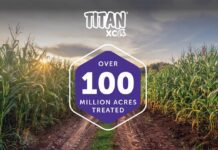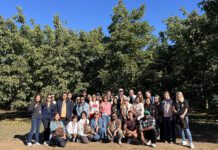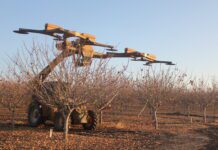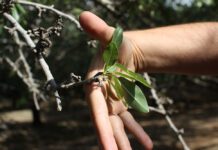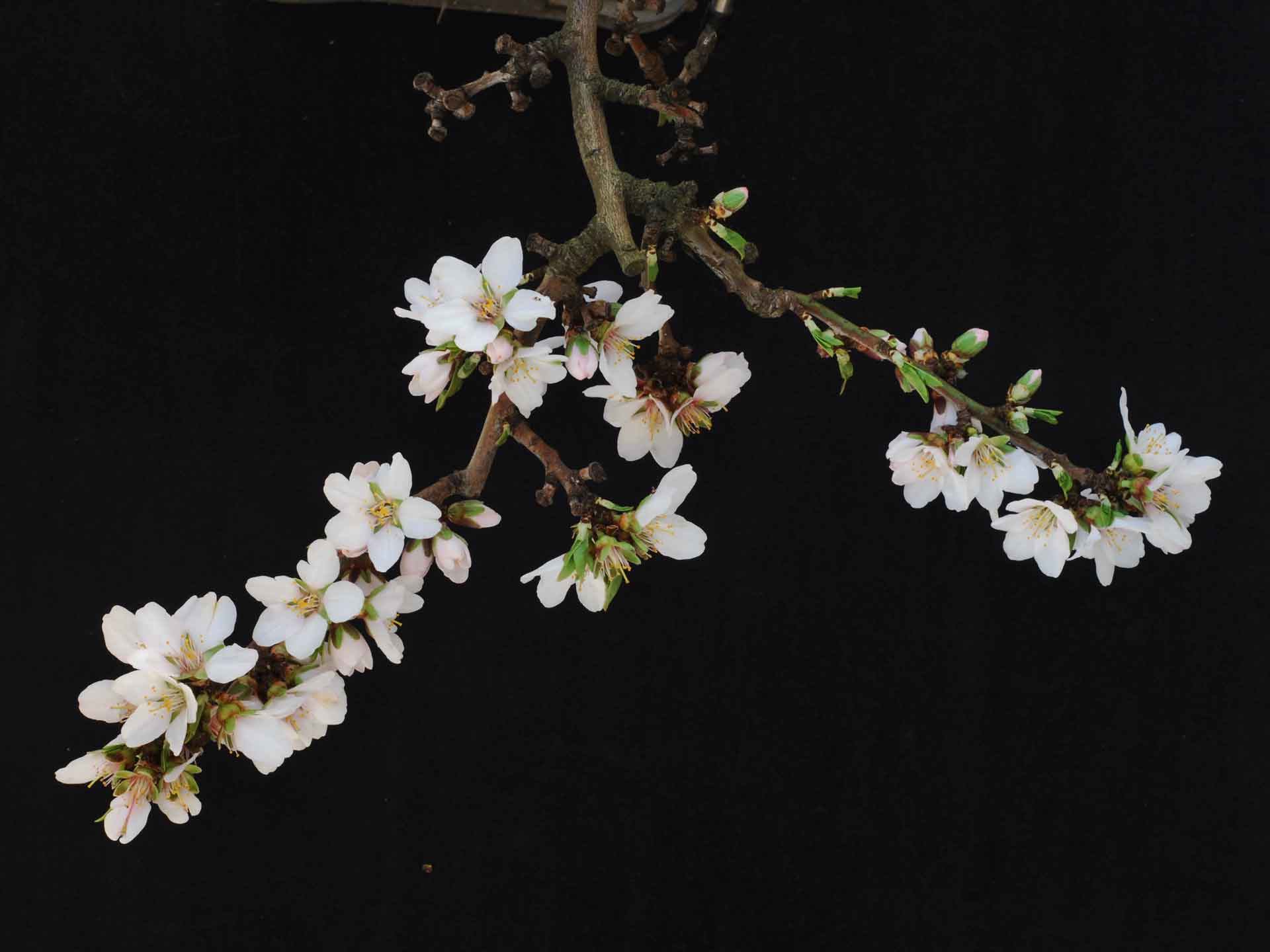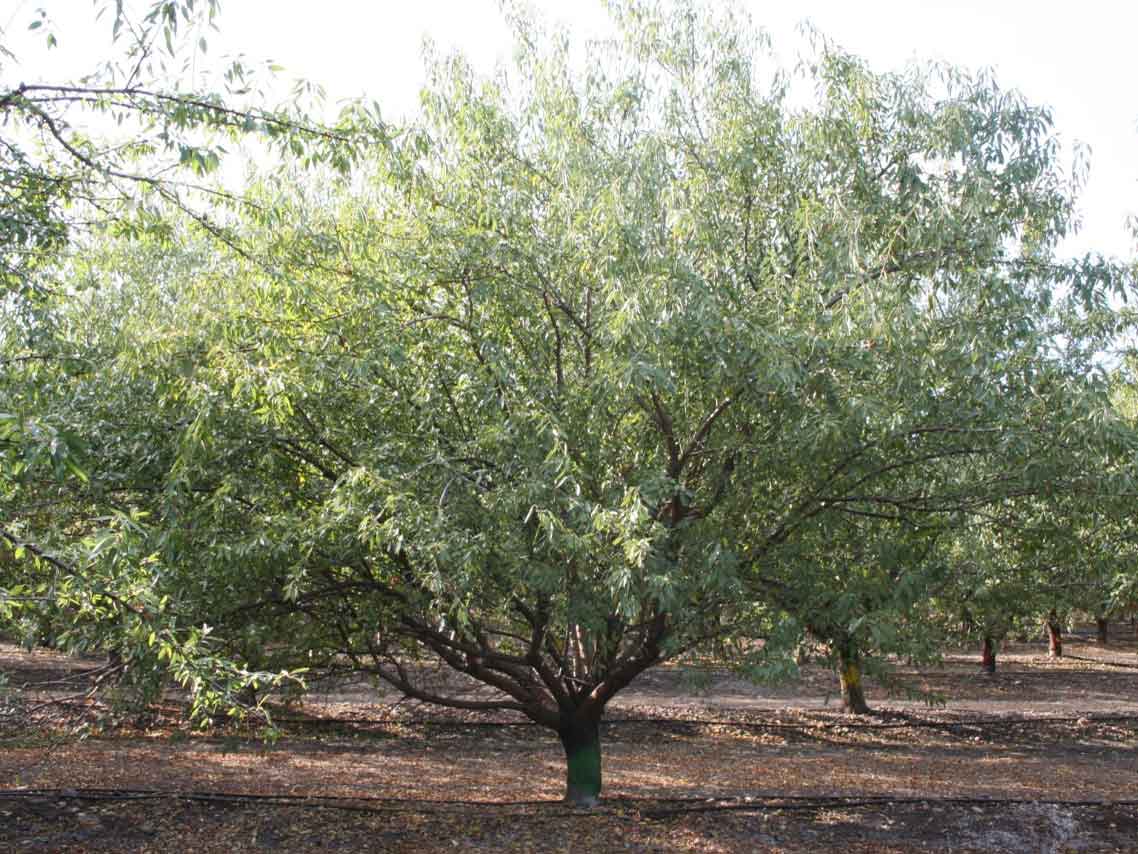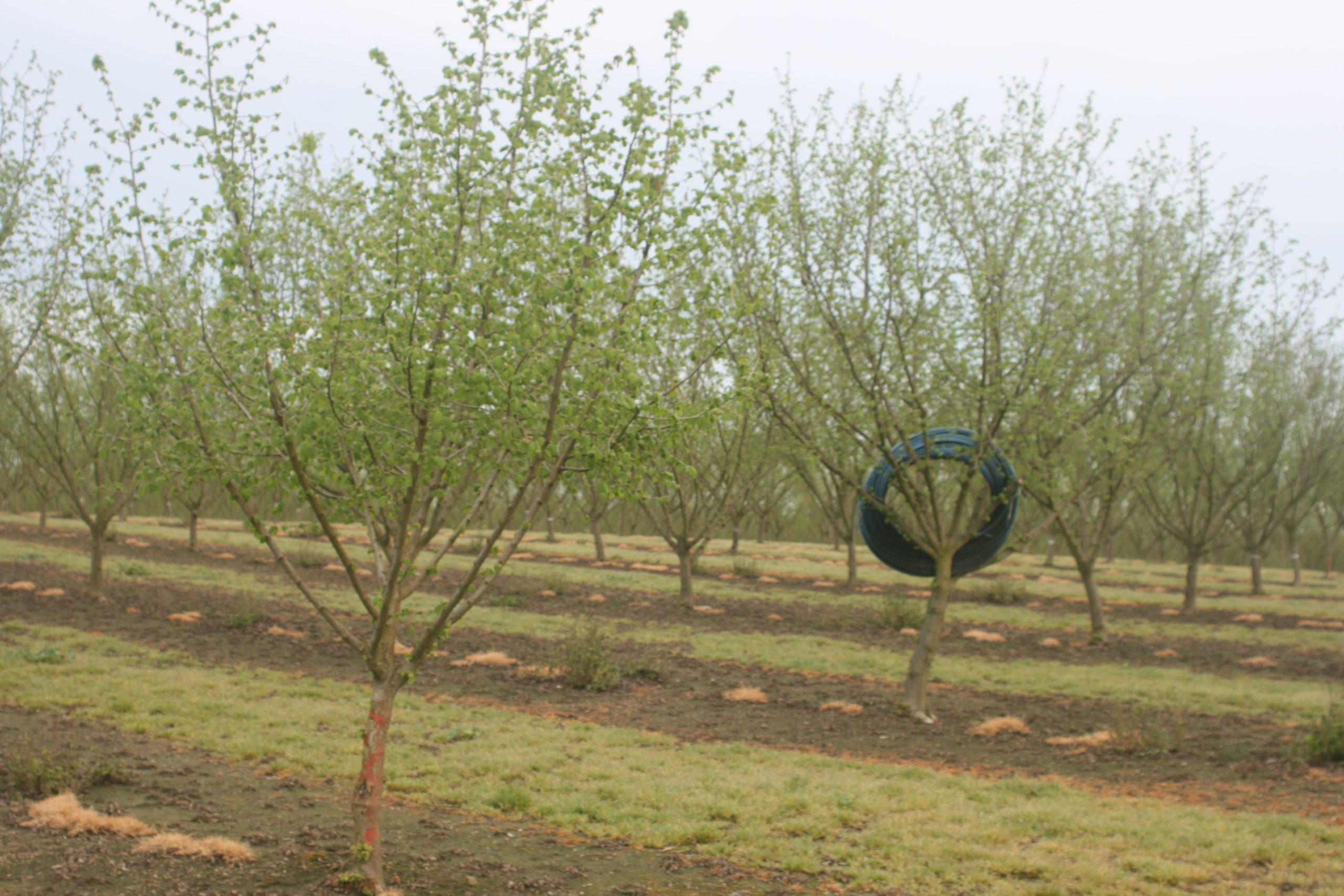The days are longer (and hopefully warmer than in March). Almond nut set should be coming into focus. If almond growing was a card game, it’s time to check the hand that Mother Nature has dealt, plan and act. April is a busy month.
Some good news is the two major reservoirs in the north state, Shasta and Oroville, are full or nearly full. For many growers, that means high-quality water for irrigation.
It was a weird year for almond bloom progression, with bloom in the Sacramento Valley ahead of that in the usually earlier blooming San Joaquin Valley. Nonpareil bloom was not strong in many orchards in the areas where I work (Colusa and Sutter/Yuba counties), while Aldrich seemed to be first out and last to petal fall.
Almonds
Irrigation
Once the irrigation season starts and lines are in shape for the season, it’s a very good idea to have the system checked out for even distribution of water (distribution uniformity). Mobile labs can help take measurements and give you a report. The services are free through local Resource Conservation Districts.
In any spring, but especially in a wet, cool spring, deciding when to start irrigation in a particular orchard can take some work. But it’s worth the effort so the trees have a smooth transition from rainfed to hose-fed water. Monitor soil and tree water status to make sure trees get adequate water as needed but not too much too early, which could saturate the soil and risk harming root health. At the same time, careful first irrigation keeps the orchard from unwanted early season water stress during the time of important shoot and nut growth. Terry Pritchard, retired UCCE irrigation specialist, used to say never start to irrigate before the soil can hold the water applied in the irrigation set. Also, plan your first irrigation with an eye to the coming weather. If an early irrigation is applied to “top off” the root zone and cool weather follows, the root zone could stay wet (and cold) for longer than if the irrigation set was shorter or not done until the skies cleared. That can be a recipe for yellow trees until the weather shifts and the trees pull down the water in the root zone.
It’s worth saying like a mantra, get irrigation right and you’re more than halfway to the best crop a particular season will allow. To get irrigation right, monitor the orchard and measure what’s being applied. Tree water status (pressure chamber) shows tree water stress and soil monitors (WaterMark, EnviroSCAN, etc.) measure soil moisture content or tension (related to soil moisture). One tells if water is needed, the other confirms how wet the soil is after irrigation. Too much, too little, how fast does it drain, how long was the soil saturated after the first irrigation? Using the results of both, irrigation can be fine-tuned.
Pests
The good news from the California 2024 almond crop is reject levels from navel orangeworm (NOW) and other pests, especially bugs, were off from the horrible 2023 numbers in the Almond Board’s Position Reports as of the end of January. The bad news is the numbers are only 25% off the 2023 numbers, making 2024 the second worst year for rejects in decades. Careful NOW monitoring and management along with true bugs (leafooted bugs, certain stink bugs, box elder bugs, etc.) and ants this spring and/or summer are still critical to the best grower income.
NOW management starts with egg and moth traps going up by March 15. Having at least four traps up in an orchard increases the chances of getting the most accurate monitoring of NOW activity. Biofix, when eggs are first found on the egg traps, is usually in early to mid-April in cooler springs in the Sacramento Valley (it’s good to get the monitoring traps for NOW in all orchards up by March 15 just to be sure.) Frank Zalom, retired UC IPM Specialist at UC Davis, told me years ago he considered the first egg “catches” in the Sacramento Valley to be biofix. That’s when degree day accumulation starts.
What about mating disruption for NOW? Research shows that season-long mating disruption (puffers or strips) paid for itself when the processor’s reject numbers were over 1%. NOW damage in almonds at Nickels Soil Lab was lowest for Nonpareil nuts (with improving inshell value) when mating disruption was used, even in the small blocks.
Another spring concern is leaffooted bug (LFB). March and into April is the general timing when adult LFB leave overwintering sites and can move into almond orchards. A few adults can cause economic damage. Adults are large (1 inch long) insects and noisy flyers. Spring scouting will help growers and PCAs detect when LFB are feeding. Look for adults (often hard to find) or signs of their feeding with gummy and/or fallen nuts. If fallen and gummy nuts are found but not adults, check for signs of LFB feeding (bruised, darker green strip of tissue reaching through the hull and shell into the kernel) by slicing through the nut from the gummy point to the kernel. If LFB damage is confirmed, control should be considered. A part of the decision-making process, the most effective LFB control treatments (pyrethroid insecticides) are the most disruptive to biological mite and scale control.
What about mites? Its early to scout for webspinning mites, but consider the recent research results from UC scientists showing six-spotted thrips can effectively control these damaging pests. Check out the YouTube video of David Haviland, UCCE entomologist, talking about his program for monitoring six-spotted thrips and research results.
Wet springs bring a risk of disease to leaves and nuts, depending on local conditions. Talk with your PCA/CCA about disease risk and control options based on disease history, current orchard conditions and forecast weather. Rust, scab, anthracnose and alternaria are spring/summer diseases that can damage leaves or nuts. Significant pre-harvest leaf loss can reduce return bloom and hurt grower returns next year.
Rust can be a particular problem in wet springs. Areas of high humidity, orchards with high nitrogen levels and late spring or summer rains favor rust development. UC IPM website on almonds recommends in orchards with a history of rust that sulfur be sprayed five weeks after petal fall (early April) followed by a FRAC 3 (Tilt, etc.) or FRAC 11 (Abound, etc.) fungicide four to five weeks later to control the disease. Several years ago, with rain in the forecast in early May, I asked an experienced PCA if he was seeing any rust symptoms and planning to recommend spraying for rust control. Yes, he said, particularly in orchards that weren’t sprayed ahead of April rains.
When spraying fungicides to protect the canopy (leaves) in the spring, sprayer speed should be slow enough to get the spray throughout the tree. A quick sprayer pass may not protect the upper canopy and so allow disease infection in those unsprayed leaves. Those infected leaves will be a source of further infection if more rain occurs later this spring. Every-other-row spraying provides every-other-row control.
Wet springs can also produce saturated soils that promote Phytophthora infection of crown and/or roots. Even rootstocks tolerant of “wet feet” and low oxygen conditions (Krymsk 86 in particular) are vulnerable to Phytophthora root/crown rot. Talk with your PCA about new and established fungicide options for Phytophthora control. Growers now have multiple, effective options. See page 37 of 2025 Fungicide Efficacy and Timing for efficacy of registered products.
Finally, aerial Phytophthora infection is a risk in wet winters. Research results indicate that phosphite materials are the most effective against aerial phytophthora.
Pests to put on your radar for later this spring and summer are stink bugs, ants and spider mites. Later spring and summer stink bug feeding can cause brown spot, so these pests are of particular concern. Dr. Sudan Gyawaly, UCCE IPM advisor in the Sacramento Valley, reminds me that box elder bugs can also be an issue in almonds, especially near orchard edges.
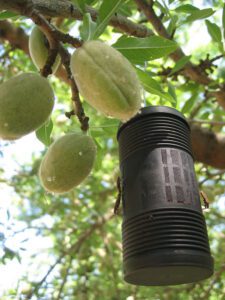
Nutrition
If it’s a big crop this year, nitrogen and potassium demand will be up and meeting that demand could cost hundreds of dollars per acre. Early season leaf sampling/analysis results can help show if crop nutrient demand is high or low. Relatively low levels of leaf N early in the season can indicate a large crop and the need for more N fertilizer. The early leaf sampling window in almonds is 45 days (±6 days) after full bloom using the UC Davis April sampling protocol. See details of the sampling and analysis (and more crucial N management info) in Best Management Practices for Nitrogen from the Almond Board of California. See page 14 for details on the early season sampling protocol. Private labs have developed their own guidelines for interpreting early season leaf sample results. Talk with your CCA about what is available.
Spring is also the time to consider orchard K needs. Almond orchard K demand is driven by crop load, with nuts containing 90 to 100 lbs K2O/1000 lbs of crop at harvest. Growers have multiple effective options available to deliver K fertilizers to almonds in-season, but costs differ. Liquid K fertilizers (KTS, 0-0-30 potassium carbonate, potassium acetate, etc.) are highly soluble, easy to handle and deliver K quickly to the roots. Ultra-fine potassium sulfate (SOP), solubilized in a “gyp machine” on-farm and injected into irrigation systems is another option. Finally, dry SOP fertilizer can be banded along drip hose and carried into the soil with irrigation water. This last option may save growers some money as the dry, field-grade SOP can be less expensive than the liquids or ultra-fine SOP.
Saving money wherever possible is a focus of growers everywhere in the current market. K fertilizer is a major cost in almond production. Because almond yield can vary from year to year and from variety to variety in the same orchard, fall banding of dry K with a maintenance rate (400 to 600 lbs of potassium sulfate/acre) across the whole planting may not efficiently match crop need. Growers looking to save money and still maintain good K nutrition in all varieties have several options. Liquid K fertilizer (purchased liquid or solubilized on farm) can be applied at different rates to different varieties, but not, as far as I know, at the same time. Risers must be turned on and off to allow different rates to be applied to different rows to match crop load in different varieties. Alternatively, lower-cost coarse field grade (dry) SOP can be banded along the drip line of the entire orchard and a second application applied over the top of the first on the varieties with heavier nut set. One band per tree row works well in my experience. Keeping adequate orchard K levels ensures strong spur health and supports consistent yields. Applying K as needed to different varieties allows growers to keep K levels up across all varieties without overspending.
Rodents
Keep after gophers, voles and ground squirrels. Gophers and voles can kill trees and ground squirrels eat profits. Talk with your PCA about options for all three pests. Fumigation regulations have changed, so make sure all paperwork is in order before use. Roger Baldwin, UC Davis human-wildlife conflict resolution specialist, recommends using two gopher control strategies for the best results. For example, first trapping gophers across a block and following up with fumigation or poison bait (applied under the ground using probe applicators) in the burrow complexes where gophers are still active after trapping.
Walnuts
Water
Recent research suggests first irrigation in walnuts can be delayed for weeks beyond the traditional start timing with little impact on the trees and water and money savings to the grower. This should be done with the help of pressure chamber readings to track orchard water status and using an irrigation threshold of -2 to -3 bars below (more negative) than baseline. This same irrigation threshold can be used all season and help reduce irrigation costs.
Pests
Walnut blight is a major pest of walnut, and the traditional approach to managing blight is a combination of two of three materials: copper, EBDC fungicide (Dithane, Manzate, etc.) or the new bactericide Kasumin® for both effective disease control and resistance management. Using just copper risks resistance buildup. Mixing copper and Dithane or Manzate provides excellent blight and anthracnose control along with decent levels of Bot (Botryosphaeria) control. Copper alone provides slightly less blight efficacy and no anthracnose or Bot control.
Phytophthora damages walnuts, too. If all or part of the orchard has been flooded this winter or spring, talk with your PCA about control options.
Nutrition
N demand per acre in walnuts is less than almond, and that demand starts later in the spring. With a crop removal of approximately 30 to 35 lbs N per ton of inshell walnuts plus 5 to 8 lbs N needed to support new shoot growth, about 120 lbs N/acre is used by mature trees carrying a 3 tons/acre crop. Adjusted for 75% nutrient use efficiency (N in the tree/N applied) means 160 lbs N/acre/year should be applied to deliver 120 lbs N/acre to the trees. How much fertilizer does that come out to? For UN32, 160 lbs N/acre works out to 500 lbs, or 45 gallons/acre of UN32. Walnut tree N use is constant through the summer, so the recommendation is to apply 25% of the annual budget each month from May through August. In the case of the example from above, this works out to 40 lbs N/acre/month, or 11.3 gallons/acre of UN32, from May through August.
K is important for productive walnut orchards and should be added to keep July leaf K levels at 1.5% K or above. K demand in walnut orchards is generally less than in almond orchards, partially because hull pieces drop through the harvester pickup chain and recycle K into the soil.
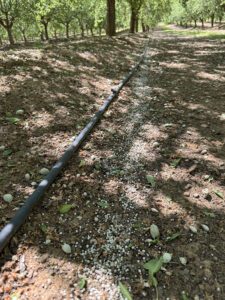
Pistachios
Disease pressure may be up in a wet spring, so as bloom and terminal shoots reach 0.5 to 1 inch length, talk with your PCA about fungicide selection and timing for Botrytis or Botryosphaeria control.
N, boron and zinc are key nutrients for pistachios as leaves expand. Foliar boron and zinc should be applied at 50% leaf expansion while N applications through irrigation typically begin in late April. Lower N rates are recommended early in the season (April and May) with increasing crop demand in June and July. K fertilizer applications may also start in the spring.
NOW traps should be up by April 1. Best wishes for a good nut set for all growers.
Resources
Climate forecast: cpc.ncep.noaa.gov/
Irrigation
Mobile irrigation labs:
• tehamacountyrcd.org/mobile-irrigation-lab
• sutterrcd.specialdistrict.org/mobile-irrigation-lab-367e01c
• yolorcd.org/what-we-do/bilingual-mobile-irrigation-lab/
This is a great, nine-article series by UCCE Advisors on using the pressure chamber to irrigate orchards: https://www.sacvalleyorchards.com/manuals/stem-water-potential/
When to start Irrigating walnuts: https://www.sacvalleyorchards.com/walnuts/irrigation-walnuts/spring-start/
Pests
Navel orangeworm: ipm.ucanr.edu/agriculture/almond/navel-orangeworm/
Spider mites:
• ipm.ucanr.edu/agriculture/almond/webspinning-spider-mites/
• youtube.com/watch?v=ufJ4VCa-IFI
Leaffooted bugs:
ipm.ucanr.edu/agriculture/almond/leaffooted-bug/
Ants: ipm.ucanr.edu/agriculture/almond/ants/
At the bottom of this page is a link to the free, 73-page document from UC IPM “Funcides, bactericides, biocontrols, and natural products for deciduous tree fruit and nut, citrus, strawberry and vine crops in California, 2022. UC Fungicide Guide: https://ipm.ucanr.edu/agriculture/
Aerial Phytophthora: sacvalleyorchards.com/almonds/trunk-soil-diseases/aerial-phytophthora-outbreaks-in-wet-years/
Nutrition
Nitrogen Best Management Practices in almond: almonds.com/almond-industry/orchard-management/soil-quality-and-nutrients/nutrient-management
UC Pistachio nitrogen and potassium model: https://fruitsandnuts.ucdavis.edu/nitrogen-prediction





